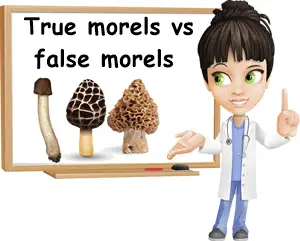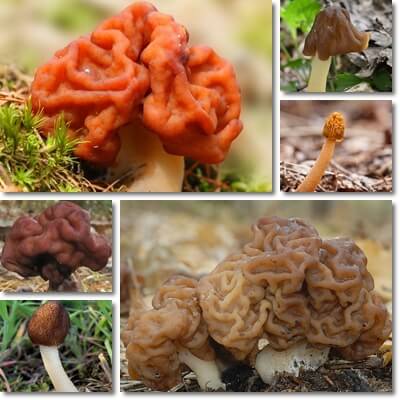Despite their unmistakable appearance, it’s not always easy to identify true morels and tell them apart from false morels. Learning to correctly identify true morels is important because there are several close look-alikes that are either inedible in their raw form, requiring specific preparation to render them safe to eat, or are poisonous causing serious side effects with sometimes long-term damage and even fatalities. You can identify a true morel mushroom by several key-features: conical cap shape with a honeycomb-like structure, plain stem or stalk appearance with tiny grains, uninterrupted, hollow interior running from the tip of the cap to the base of the stem and attachment of the stem to the base of the cap, or slightly higher in some species.
- If you want to learn how to identify a true morel vs false morel mushroom, consider the following key-features of true morels:
- Cap shape: conical, or fir tree-like.
- Cap appearance: honeycomb-like structure.
- Stem or stalk appearance: stem is same width from top to bottom or club-shaped (wider or bulbous at the base); there are also grain-like structures present on it.
- Interior: hollow (very important difference between true and false morels).
- Attachment: the cap is attached to the stem at its base, or, in the case of half-free morels, slightly higher, about midway into the cap (so the cap in morel mushrooms is not umbrella-like, hanging like a skirt on the stem).
Find out below what are the closest look-alikes.

Verpa bohemica
It’s a species of mushroom known as the ‘early false morel’ because its season starts before that of true morels and continues for the duration of morel season (roughly March/April-May/June). Another common name for it is ‘wrinkled thimble-cap’, suggestive of its appearance: a smaller, thimble-like cap that is visibly wrinkled, unlike true morels which are honeycomb-like. The cap of Verpa bohemica mushrooms looks more like a brain. Moreover, the brain-like cap is attached to the stem only at the top, hanging on the stem like an umbrella or a skirt. Unlike true morels in which the caps are attached to the stems either at their base or halfway through (the second being known as ‘half-free morels’).
Verpa bohemica is a close look-alike of Morchella semilibera, or the half-free morel, except V. bohemica is attached to the stem at the top of the cap, while M. semilibera is attached to the stem halfway through the cap. The difference is clear if you cut the mushrooms in half lengthwise. Lastly, young Verpa bohemica specimens are stuffed with a cotton-like tissue, but become hollow as they mature, versus true morels which are always hollow. Actually, only the stem of V. bohemica is stuffed since the cap is attached to it at the top only.
Verpa bohemica edibility is questionable, to say the least. The mushroom is sometimes listed as edible, but noted to require cooking prior to consumption to make it safe to eat. At the same time, numerous Verpa bohemica poisonings have been recorded. These have been attributed to consumption of the raw or undercooked mushroom or to an excessive intake (either eating too much of the mushroom at once or eating it every single day for several days in a row). Side effects include: gastrointestinal upset (stomach cramps, feeling of unwell, nausea, vomiting sensation, loose stools and diarrhea), muscle coordination problems and, in rare cases, fatalities. In view of reports, Verpa bohemica is considered by some sources a poisonous morel mushroom look alike, so its correct identification is imperative.

Verpa conica
Verpa conica is a close morel look-alike, related to Verpa bohemica. Two photos in the collage above (small photo top right and small photo bottom left) picture V. conica mushrooms. Compared to true morels, Verpa conica mushrooms are attached to the stem only at the top of the cap, so their cap is hanging freely on the stem like an umbrella or a skirt. Also, V. conica mushrooms don’t have honeycomb-like patterned caps and young specimens are filled with cotton-like tissue, although they may become hollow with age. Edibility is questionable, although the species is not listed as inedible, toxic or poisonous. However, it is strongly recommended to cook it well prior to consumption to render it safe to eat. Even so, side effects ranging from gastrointestinal discomfort to toxicity to allergic reactions may occur in some people.
Gyromitra mushrooms
Several Gyromitra mushrooms can be mistaken for morels, such as Gyromitra esculenta or Gyromitra caroliniana. But unlike true morels with their honeycomb-like, conical caps, the two Gyromitra species have irregularly-shaped caps that are brain-like in appearance. If you cut them lengthwise, you should be able to notice true morels are attached to the stem at the base (or almost halfway through in the case of half-free morels) and are hollow inside, from the top of the cap to the base of the stem. Whereas the two Gyromitra species attach to the stem in multiple points (since the cap is irregularly-shaped) and are not hollow. In fact, the Gyromitra are filled with a densely-packed, whitish flesh that forms a tree-like shape at the points of attachment and empty/hollow chambers or pockets of air, especially visible in the cap, between the points of attachment. In the collage above, the bigger top and bottom pics and the smaller top left pic depict Gyromitra mushrooms.
As for edibility, it is a known fact most Gyromitra mushrooms contain varying amounts of toxins with potentially serious side effects for health, so they are generally not recommended for consumption. Yet some species are readily consumed and presumed safe to eat with proper preparation (parboiling, boiling, drying etc.). For example, Gyromitra caroliniana is reported to be toxic, but said to be rendered safe to eat by boiling. However, the general consensus is it should not be eaten.
Gyromitra esculenta on the other hand is a proven poisonous false morel mushroom that should not be eaten regardless of preparation (parboiling, boiling or other forms of cooking have not been proven to render it safe to eat). The species contains the toxin gyromitrin which is metabolized to the toxin and carcinogen monomethylhydrazine (used as rocket propellant). The toxin interacts with the active form of vitamin B6 in the body and subsequently causes damage to the nervous system and the liver, but also kidneys, gastrointestinal system and red blood cells.
- Side effects include:
stomach upset, cramps, nausea, vomiting, diarrhea (also with blood), headaches, dizziness, tremors, lack of muscle coordination, muscle weakness and fever. For some people, the symptoms may progress over the course of several hours or days to jaundice, liver damage, kidney damage, destruction of red blood cells, shortness of breath, blue or purple discoloration of skin, mental confusion, muscle spasms, seizures and coma. It is imperative to seek medical help immediately if you experience any gastrointestinal or other side effects following consumption of mushrooms, especially mushrooms foraged from the wild. Treatment includes addressing every symptom and its underlying cause.
Conclusion
- What is the difference between true morels vs false morels?
- While true morels are also reported to contain toxins, their toxicity is inactivated by cooking (parboiling, boiling, frying). See benefits of morels. Most species of false morels are not rendered safe to eat with cooking.
- True morels have a honeycomb-like, conical cap, whereas the cap in V. bohemica and Gyromitra mushrooms is wrinkled and looks more like a brain than a honeycomb.
- In true morels, the cap is attached to the stem at the base (or near it in half-free morels such as Morchella populiphila). In V. bohemica and V. conica, the cap is attached to the stem at the top only, meaning it’s hanging free on the stem, similar to a skirt or umbrella.
- True morels are empty inside. Verpa mushrooms (V. bohemica, V. conica) are stuffed with cotton-like tissue fibers, although they may appear hollow with age. Gyromitra mushrooms have a densely-packed whitish flesh, branched like a tree (owed to the irregularity of the cap), with empty/hollow chambers or pockets of air.
